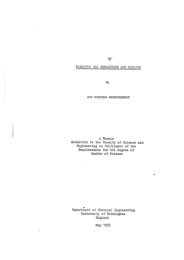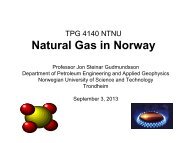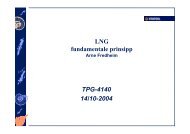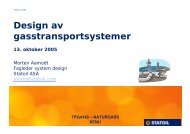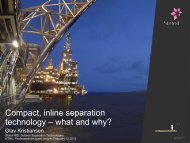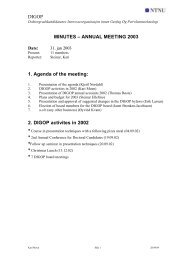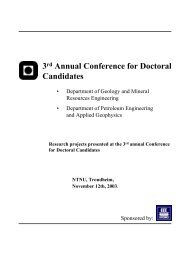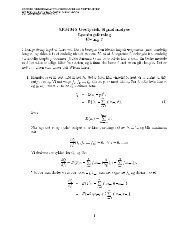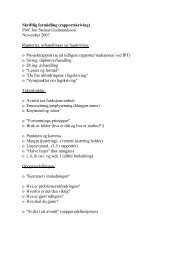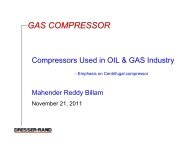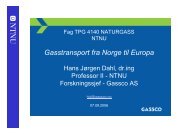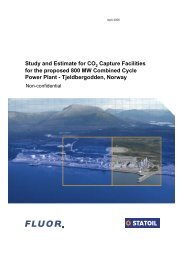Design of Gas Transport Systems - NTNU
Design of Gas Transport Systems - NTNU
Design of Gas Transport Systems - NTNU
Create successful ePaper yourself
Turn your PDF publications into a flip-book with our unique Google optimized e-Paper software.
<strong>Design</strong> <strong>of</strong> <strong>Gas</strong> <strong>Transport</strong> <strong>Systems</strong><br />
11 September 2013<br />
Elin Kristin Dale<br />
ekrd@statoil.com<br />
1 -<br />
TPG4140 – NATURGASS, <strong>NTNU</strong>
<strong>Design</strong> <strong>of</strong> gas transport systems<br />
• Part 1:<br />
− Intro Pipeline <strong>Transport</strong> Technology<br />
− <strong>Gas</strong>/condensate fields- and infrastructure development<br />
− System design <strong>of</strong> pipelines – terms and definitions<br />
• Part 2:<br />
− <strong>Design</strong> premises included examples<br />
− System design <strong>of</strong> multiphase pipelines<br />
− Pipeline pressure protection and leak detection<br />
2 -<br />
TPG4140 – NATURGASS<br />
<strong>NTNU</strong>
Part 1<br />
Intro Pipeline <strong>Transport</strong> technology<br />
3 -<br />
TPG4140 – NATURGASS<br />
<strong>NTNU</strong>
Pipeline <strong>Transport</strong> Technology<br />
“Development <strong>of</strong> total transport solutions - from Reservoir to Market”<br />
4 -<br />
TPG4140 – NATURGASS<br />
<strong>NTNU</strong>
Reservoir<br />
conditions<br />
Pipeline <strong>Transport</strong> Technology<br />
Market<br />
conditions<br />
‣ System definition<br />
‣ Hydraulic analysis<br />
‣ Optimisation <strong>of</strong> flow in pipeline network wrt<br />
capacity and gas quality management<br />
‣ Principles for pressure control and pressure<br />
protection<br />
‣ Interface management<br />
‣ Supervision, consultation and daily operation <strong>of</strong><br />
leak detection system (PM-vakt)<br />
PLEM<br />
5 -<br />
TPG4140 – NATURGASS<br />
<strong>NTNU</strong>
The Norwegian Continental Shelf<br />
• Statoil has developed the world’s largest<br />
<strong>of</strong>fshore gas pipeline network<br />
• Technical services are provided by Statoil for<br />
the world's most extensive submarine gas<br />
pipeline system:<br />
− 7800 km pipelines (30” – 44”)<br />
− Long term transport capacity approx.<br />
365 MSm 3 /d<br />
• Statoil is the leader in the construction <strong>of</strong><br />
large-diameter pipelines in deep water.<br />
• On 1 st January 2002, <strong>Gas</strong>sco became the<br />
operator for most <strong>of</strong> the gas pipeline systems<br />
from the Norwegian continental shelf.<br />
• On 1 st January 2003, <strong>Gas</strong>sled became the<br />
owner for most <strong>of</strong> the gas pipeline systems<br />
(Statoil share 5%, Statoil+Petoro share 50,8<br />
%).<br />
6 -<br />
TPG4140 – NATURGASS<br />
<strong>NTNU</strong>
7 -<br />
<strong>Gas</strong>/condensate fields- and infrastructure<br />
development
<strong>Gas</strong> transport technology<br />
Volume<br />
50<br />
BCM<br />
20<br />
10<br />
5<br />
PIPELINE<br />
(North sea)<br />
CNG<br />
LNG<br />
(Barents sea)<br />
Floating LNG<br />
GTL/Methanol<br />
2<br />
1<br />
.50<br />
Electricity<br />
(HVDC)<br />
UNECONOMIC<br />
1000 2000 3000 4000 5000<br />
Distance to market - Km<br />
8 -<br />
TPG4140 – NATURGASS<br />
<strong>NTNU</strong>
<strong>Transport</strong> analysis<br />
New fields:<br />
• Volume pr<strong>of</strong>iles<br />
• Type gas<br />
• Pr<strong>of</strong>itability<br />
• Geography<br />
• Owners<br />
<strong>Transport</strong><br />
Solutions<br />
Cost<br />
estimation<br />
Economical<br />
analyse<br />
Infrastructure<br />
• Spare capacity<br />
• Liquid recov.<br />
• Tariffs<br />
• Owners<br />
• Distance<br />
• Capacity<br />
• Tie-ins<br />
• Processing<br />
• Liquid recov..<br />
• CO2 removal<br />
• CAPEX<br />
• OPEX<br />
• NPV<br />
• IRR<br />
• Pr<strong>of</strong>it index<br />
• Investment<br />
equivalent 7%<br />
after tax.<br />
Overall<br />
evaluation<br />
• SDA/SØA economy<br />
• Strategic fit<br />
• Stakeholders<br />
• Flexibility<br />
Market:<br />
• Supply situation<br />
• Geography<br />
• Pricing<br />
9 -<br />
TPG4140 – NATURGASS<br />
<strong>NTNU</strong>
<strong>Gas</strong>/condensate fields- and infrastructure<br />
development<br />
• <strong>Gas</strong> supply<br />
− Production pr<strong>of</strong>ile<br />
− Build-up and plateau level<br />
• Market scenarios<br />
− Volume<br />
− Market opportunities (and flexibility)<br />
− Company based sales<br />
• Existing infrastructure<br />
− Platforms<br />
• Tie-ins and functional<br />
requirements<br />
− Pipelines<br />
• Capacity and ullage<br />
• New infrastructure requirements<br />
10 -<br />
TPG4140 – NATURGASS<br />
<strong>NTNU</strong>
Dry gas pipelines<br />
Reference: Flow <strong>of</strong> oil and gas in<br />
pipelines<br />
• What are needed to find pipeline capacity?<br />
− Pipeline length<br />
− Bulk temperature<br />
− Inlet pressure<br />
− Outlet pressure<br />
− Molar weight <strong>of</strong> the gas<br />
− Roughness <strong>of</strong> the pipeline<br />
− Diameter <strong>of</strong> the pipeline<br />
Q<br />
SC<br />
=<br />
2<br />
− p<br />
2<br />
)<br />
1 2<br />
T ( p<br />
137.2<br />
SC<br />
D<br />
P zMTL<br />
SC<br />
− Deposits in the pipeline<br />
2.666<br />
11<br />
TPG4140 – NATURGASS<br />
<strong>NTNU</strong>
Existing infrastructure - capacity<br />
• The pipeline between X and Y is<br />
the main link between the<br />
production at A and B and the<br />
terminal E.<br />
• Utilisation <strong>of</strong> the XY link affects the<br />
capacity towards E, creating a<br />
bottleneck and a gap between the<br />
actual delivery and the demand.<br />
• Routing <strong>of</strong> the gas will determine<br />
the possible transportation capacity<br />
at a given scenario.<br />
• The sum <strong>of</strong> exit capacity in a<br />
transport system is not necessarily<br />
equal the actual transport capacity.<br />
• <strong>Transport</strong> capacity is dependent on<br />
volume scenario, bottlenecks and<br />
dependencies.<br />
A B C<br />
D<br />
Tie-in new field – increased production<br />
from 10 to 30 MSm3/d<br />
14,7 20 20 10<br />
15<br />
X<br />
Producers<br />
19,7<br />
Production scenario 1 [MSm 3 /d]<br />
Exit terminals<br />
A B C D E<br />
Y<br />
Gap: ~15<br />
49,7<br />
E<br />
10 -> 30 40 10 15 65<br />
12 -<br />
TPG4140 – NATURGASS<br />
<strong>NTNU</strong>
Overall field architecture case – Johan Sverdrup<br />
• Example <strong>of</strong> business case:<br />
− New field discovery Johan Sverdrup, largest<br />
finding in the world in 2010/2011<br />
− 0,9-1,5 Bill barrels oil equivalents, 140 km<br />
<strong>of</strong>fshore, 110 meter depth, 1900 meter below<br />
the seabed<br />
− Production horizon to 2050<br />
− Which field architecture will you recommend to<br />
your management ?<br />
• Some <strong>of</strong> the parameters to be evaluated :<br />
− Technical: Choice <strong>of</strong> installation (floater, fixed structure), store or transport, processing,<br />
naval architecture, sensitivity to weather/sea conditions (hurricane, waves, tide,<br />
temperature etc), fluid properties (wax, hydrates, corrosion etc.), pigging, ship transport<br />
path, design codes, infrastructure (helicopter base, logistics, storage equipment/fluids,<br />
accommodation) and pressure protection and leak detection.<br />
− Economic analyses: availability in marked, location <strong>of</strong> construction, rent or own,<br />
distance from field to market, pipeline transport fee, country laws and regulations,<br />
personnel availability, company philosophy.<br />
13 -<br />
TPG4140 – NATURGASS<br />
<strong>NTNU</strong>
Pipeline system design<br />
Terms and definitions<br />
14<br />
-
Pipeline system design – terms and definitions<br />
• Pipeline system<br />
• Pipeline<br />
− A pipeline with compressors or pump stations<br />
− Pressure reduction stations<br />
− Metering<br />
− Tankage<br />
− Supervisory control and data acquisition system (SCADA)<br />
− Safety systems<br />
− Corrosion protection systems<br />
Petroleum and natural gas industries<br />
Pipeline transportation systems, ISO<br />
13623<br />
− And other equipment, facility or building used in the transportation <strong>of</strong> fluids<br />
− Those facilities through which fluids are conveyed, including pipe, pig traps,<br />
components and appurtenances, up to and including the isolation valve.<br />
15 -<br />
TPG4140 – NATURGASS<br />
<strong>NTNU</strong>
Pipeline system design – system definition<br />
• The extent <strong>of</strong> the pipeline system, its functional requirements and applicable legislation<br />
should be defined and documented.<br />
• The extent <strong>of</strong> the system should be defined by describing the system, including the<br />
facilities with their general locations and demarcations and interfaces with other facilities.<br />
• The functional requirements should define the required design life and design conditions.<br />
Foreseeable normal, extreme and shut-in operating conditions with their possible ranges<br />
in flow rates, pressures, temperatures, fluid compositions and fluid qualities should be<br />
identified and considered when defining the design conditions.<br />
Petroleum and natural gas industries<br />
Pipeline transportation systems, ISO 13623<br />
OS F-101: Submarine Pipeline<br />
<strong>Systems</strong><br />
16 -<br />
TPG4140 – NATURGASS<br />
<strong>NTNU</strong>
Pipeline systems<br />
Subsea Production <strong>Systems</strong> (ISO 13628) and<br />
Pipeline <strong>Transport</strong>ation <strong>Systems</strong> (ISO 13623)<br />
ESV<br />
Platform/Floater<br />
PIG TRAP<br />
Subsea<br />
Production<br />
HIPPS<br />
SUBSEA<br />
PROCESSING<br />
UNIT<br />
Subsea isolation<br />
SSIV<br />
ESV<br />
PIG TRAP<br />
MANIFOLD<br />
X-MAS<br />
TREE<br />
PWV<br />
PMV<br />
CHOKE<br />
BRANCH<br />
RISER BASE<br />
SSIV<br />
CHECK<br />
SCSSV<br />
CHOKE<br />
MODULE<br />
TEMPLATE AND<br />
MANIFOLD<br />
LANDFALL<br />
ESV<br />
Onshore<br />
PIG TRAP<br />
Pipeline <strong>Systems</strong>: Subsea connection<br />
Single phase; <strong>Gas</strong>, Oil, condensate<br />
TEE<br />
CHECK + BLOCK<br />
Multiphase;<br />
PLEM<br />
17 -<br />
TPG4140 – NATURGASS<br />
<strong>NTNU</strong>
Pipeline Project Organisation (Typical)<br />
Project Manager<br />
Project Control<br />
Authority<br />
Procurement<br />
HSE<br />
Upstream<br />
Downstream<br />
Platform/Terminal<br />
Platform/Terminal<br />
Administration<br />
EIA<br />
Pipeline<br />
Engineering<br />
System/RFO<br />
Pipeline<br />
Construction<br />
Landfall<br />
Preparation for<br />
Operation<br />
18 -<br />
TPG4140 – NATURGASS<br />
<strong>NTNU</strong>
" I draw lines, I don't move trees"<br />
19 -<br />
TPG4140 – NATURGASS<br />
<strong>NTNU</strong>
Pipeline system design – work process<br />
Thermohydraulic<br />
analysis<br />
Functional<br />
requirements;<br />
gas routing,<br />
regularity,<br />
gas quality,<br />
agreements<br />
Overall<br />
Operational<br />
Philosophy;<br />
Control and<br />
Safety<br />
System,<br />
Environment,<br />
etc.<br />
System design<br />
concept<br />
Internal diameter,<br />
capacity, pressure<br />
and temperature<br />
pr<strong>of</strong>ile, etc.<br />
Functional<br />
requirements,<br />
Regularity,<br />
Deliverability<br />
Control and Safety<br />
Philosophy<br />
Pipeline System<br />
Diagram, Process<br />
Flow Diagram<br />
P&ID’s<br />
QA<br />
Boundary conditions and technical interface between platform – pipeline – terminal<br />
20 -<br />
TPG4140 – NATURGASS<br />
<strong>NTNU</strong>
Part 2<br />
<strong>Design</strong> premises<br />
Hydraulic capacity and gas quality<br />
21 -<br />
Photo credit: Manfred Jarisch / StatoilHydro<br />
TPG4140 – NATURGASS<br />
<strong>NTNU</strong>
Pipeline system design – Hydraulic analysis 1/2<br />
• The objective <strong>of</strong> the system design<br />
− develop overall transport solutions for the gas chain from the field<br />
to the market which will maximize the value <strong>of</strong> the liquid- and gas<br />
products and without any unreasonable external conditions for<br />
any third party (fields or transport systems).<br />
− deliver gas quantities nominated by the buyers within the desired<br />
quality specifications.<br />
− ensure high availability and regularity within reasonable technical<br />
and economical limits and relevant agreements.<br />
22 -<br />
TPG4140 – NATURGASS<br />
<strong>NTNU</strong>
Pipeline system design – Hydraulic analysis 2/2<br />
• The hydraulics <strong>of</strong> the pipeline system should be analysed to demonstrate that the<br />
system can safely transport the fluids for the design conditions specified by the<br />
system definition, and to identify and determine the constraints and requirements for<br />
its operation. This analysis should cover steady-state and transient operating<br />
conditions.<br />
• Describe the function loads for the pipeline design<br />
− Pressure pr<strong>of</strong>ile<br />
− Temperature pr<strong>of</strong>ile<br />
− Density pr<strong>of</strong>ile (fluid)<br />
− Velocity pr<strong>of</strong>ile<br />
• <strong>Design</strong> cases:<br />
− Normal operation, start-up, planned shut-down, etc.<br />
− Not planned operation, emergency shut-down, depressurisation, etc.<br />
− Emergency preparedness analysis; accidents, pipe rupture, leakage etc.<br />
23 -<br />
TPG4140 – NATURGASS<br />
<strong>NTNU</strong>
Pipeline system design – <strong>Design</strong> premises 1/3<br />
• Pipeline Route<br />
− Length<br />
− Bathymetric pr<strong>of</strong>ile<br />
• Environmental Conditions<br />
− Air temperature<br />
− Sea bottom temperature<br />
− Ground temperature<br />
− Geo-technical data (soil conditions)<br />
Temperature, °C<br />
Area B - Åsgard <strong>Transport</strong>, Kårstø temp.<br />
High Rough Likely Rough Low Rough<br />
5<br />
3<br />
1<br />
-1<br />
-3<br />
66 68 70 72 74 76 78 80 82 84 86<br />
Hydraulic capacity, MSm³/d<br />
Area B - Åsgard <strong>Transport</strong>, Kårstø pressure<br />
High Rough Likely Rough Low Rough<br />
Pressure, barg<br />
130<br />
125<br />
120<br />
115<br />
110<br />
105<br />
100<br />
95<br />
90<br />
85<br />
80<br />
66 68 70 72 74 76 78 80 82 84 86<br />
Hydraulic capacity, MSm³/d<br />
24 -<br />
TPG4140 – NATURGASS<br />
<strong>NTNU</strong>
Hydraulic capacity – Sensitivity analysis<br />
Variation <strong>of</strong> parameters and hydraulic capacity compared to basis<br />
Zeebrugge 69.5 MSm³/d (october)<br />
5<br />
Trenching -200 Km<br />
Length +/-10 Km<br />
4<br />
3<br />
Temperature<br />
10 micron<br />
2<br />
Roughness 1- 3 micron<br />
1<br />
<strong>Gas</strong> Composition<br />
-2 -1.5 -1 -0.5 0 0.5 1 1.5 2 2.5 3<br />
25 -<br />
TPG4140 – NATURGASS<br />
<strong>NTNU</strong>
Pipeline system design – <strong>Design</strong> premises 2/3<br />
• Pipeline Data<br />
− <strong>Design</strong> pressure<br />
− <strong>Design</strong> temperature<br />
− Internal diameter<br />
− Wall thickness<br />
− Internal coating<br />
− Concrete coating<br />
− Insulation<br />
− Trenching/dredging<br />
− Gravel/rock dumping<br />
26 -<br />
TPG4140 – NATURGASS<br />
<strong>NTNU</strong>
Langeled Bredero Shaw i Farsund Sept. 2004<br />
Concrete coating<br />
(330 000 m 3 )<br />
= 1,5 Troll A GBS<br />
Total pipeline steel<br />
(962 000 t)<br />
= 40 Troll A deck<br />
Coating<br />
(25 000 t)<br />
= 3 Eiffel Towers<br />
Total coating “wire”:<br />
(51 900km)<br />
= 1.3 times<br />
around the equator<br />
1200 km a 12m pipes:<br />
Per pipe:<br />
Ca 25 tonns<br />
27 -<br />
TPG4140 – NATURGASS<br />
<strong>NTNU</strong>
The largest laying vessels<br />
Solitaire:<br />
The worlds largest pipeline laying<br />
vessel at Nyhamna<br />
Acergy Piper:<br />
At Sleipner T at start-up <strong>of</strong> the laying<br />
process<br />
28 -<br />
TPG4140 – NATURGASS<br />
<strong>NTNU</strong>
Pipeline system design – <strong>Design</strong> premises 3/3<br />
• <strong>Gas</strong> properties<br />
− Equation <strong>of</strong> state<br />
• <strong>Gas</strong> composition<br />
• Friction equation<br />
− Internal roughness<br />
• <strong>Transport</strong> specification<br />
• Sales gas specifications<br />
• Pressure Control System<br />
− Pressure regulating<br />
− Pressure safety<br />
• Pig trap arrangement<br />
− Pigging philosophy<br />
• Pipeline valve philosophy<br />
• Future requirements<br />
29 -<br />
TPG4140 – NATURGASS<br />
<strong>NTNU</strong>
<strong>Transport</strong> <strong>of</strong> 42” subsea pipeline<br />
valve<br />
• Double expanding gate<br />
• Weight <strong>of</strong> valve: 80 tons (60 cars..)<br />
• 10m high including activator:<br />
• Total <strong>of</strong> 100 tons<br />
30 -<br />
TPG4140 – NATURGASS<br />
<strong>NTNU</strong>
Why gas quality specifications?<br />
• Ensure interoperability /interchangeability (WI)<br />
• Ensure unproblematic transport <strong>of</strong> gas<br />
− Max/min temperature and pressure<br />
• Prevent corrosion and erosion <strong>of</strong> equipment<br />
− Water, CO 2 , H 2 S content<br />
• Prevent condensation <strong>of</strong> liquid (HC dew point)<br />
• Prevent gas hydrates (Water dew point)<br />
Hydrocarbon dew-point (-3 C, 69 barg)<br />
Water dew-point (-12 C, 69 barg)<br />
CO2 content (max 2.5 % mol)<br />
H2S content (5 mg/Nm3)<br />
GCV (Gross calorific value)<br />
Wobbe index (WI)<br />
Max/min pressure and temperature<br />
31 -<br />
TPG4140 – NATURGASS<br />
<strong>NTNU</strong>
Hydrates – main reason for temperature<br />
control in multiphase pipelines<br />
32 -<br />
TPG4140 – NATURGASS<br />
<strong>NTNU</strong>
33<br />
-<br />
System design <strong>of</strong> multiphase pipelines
The diameter dilemma <strong>of</strong> long gas-condensate<br />
pipelines<br />
Pressure drop (bara)<br />
50<br />
40<br />
30<br />
20<br />
Technical feasibility – for how long can reservoir drive production to shore?<br />
• Minimize pressure drop ⇒ large pipe diameter<br />
Operational acceptability – will system availability be high enough?<br />
• Minimize liquid inventory in pipeline ⇒ small pipe diameter<br />
Large<br />
ID<br />
Small<br />
ID<br />
<strong>Design</strong><br />
rate<br />
20 22 24 26 28 30 32 34<br />
<strong>Gas</strong> rate (MSm 3/ d)<br />
Liquid content (m 3 )<br />
8000<br />
7000<br />
6000<br />
5000<br />
4000<br />
3000<br />
2000<br />
1000<br />
0<br />
Large<br />
ID<br />
Small<br />
ID<br />
<strong>Design</strong><br />
rate<br />
24 26 28 30 32 34<br />
<strong>Gas</strong> rate (MSm 3 /d)<br />
34 -<br />
TPG4140 – NATURGASS<br />
<strong>NTNU</strong>
Conventional design <strong>of</strong> gas-condensate pipelines<br />
Pressure drop (bara)<br />
50<br />
40<br />
30<br />
20<br />
Pipeline diameter: small<br />
• Minimize liquid inventory<br />
‣ Accept moderate/high pressure drop<br />
Slug-catcher size set by:<br />
• Rate increase:<br />
‣From maximum turndown to design<br />
rate<br />
• Pigging<br />
‣ Liquid inventory prior to pigging<br />
Maximum<br />
turndown<br />
<strong>Design</strong> pressure<br />
drop<br />
<strong>Design</strong><br />
rate<br />
20 22 24 26 28 30 32 34<br />
<strong>Gas</strong> rate (MSm 3/ d)<br />
Liquid content (m 3 )<br />
8000<br />
7000<br />
6000<br />
5000<br />
4000<br />
3000<br />
2000<br />
1000<br />
Slug-catcher<br />
0<br />
volume<br />
Troll slug-catcher<br />
Maximum<br />
turndown<br />
Steady state<br />
liquid content<br />
<strong>Design</strong><br />
rate<br />
24 26 28 30 32 34<br />
<strong>Gas</strong> rate (MSm 3 /d)<br />
35 -<br />
TPG4140 – NATURGASS<br />
<strong>NTNU</strong>
New design <strong>of</strong> gas-condensate pipelines<br />
Pipeline diameter: large<br />
• Minimize pressure drop<br />
‣ Accept relatively large liquid inventory<br />
• If possible, alleviate liquid load<br />
‣ Multi-diameter pipelines/dual lines<br />
• Exploit pipeline’s slow response to transients<br />
‣ Operational procedures<br />
Pressure drop (bara)<br />
50<br />
40<br />
30<br />
20<br />
Large<br />
ID<br />
Small<br />
ID<br />
20 22 24 26 28 30 32 34<br />
<strong>Gas</strong> rate (MSm 3/ d)<br />
Slug-catcher design<br />
• Exploit pipeline’s slow response to transients<br />
‣ Reduce slug-catcher size<br />
• Onshore reception system routes liquid to<br />
<strong>of</strong>f-spec tank<br />
‣ Optimise slug-catcher design<br />
Volume rate (m 3 /h)<br />
300<br />
200<br />
100<br />
0<br />
Liquid flow into slug-catcher<br />
0 2 4 6 8 10 12 14<br />
Time (days)<br />
36 -<br />
TPG4140 – NATURGASS<br />
<strong>NTNU</strong>
Pipeline integrity and leak detection<br />
37<br />
-<br />
Classification: Internal 2011-02-21<br />
Deepwater horizon
Pipeline integrity and leak detection<br />
Probability reduction<br />
Consequence reduction<br />
Robust<br />
design<br />
Safe<br />
operation<br />
Integrity<br />
management<br />
Leak<br />
detection<br />
Emergency<br />
response<br />
38 -<br />
TPG4140 – NATURGASS<br />
<strong>NTNU</strong>
PPS and PPC<br />
39 -<br />
TPG4140 – NATURGASS<br />
<strong>NTNU</strong>
Risk reduction<br />
Allocations <strong>of</strong> risk reducing measures<br />
Achieved freq <strong>of</strong><br />
overpressure<br />
Acceptable risk<br />
( Frequency <strong>of</strong><br />
overpressure )<br />
Frequency <strong>of</strong><br />
overpressure<br />
Without risk reduction<br />
1x10 - 5<br />
1 times pr year<br />
•Facilities regulation §33<br />
•ISO 10418 (API 14 C)<br />
•IEC 61508<br />
•IEC 61511<br />
Required risk reduction<br />
Actual risk reduction<br />
PPS - 2 PPS - 1 PPC<br />
Manuel<br />
actions<br />
Frequency <strong>of</strong><br />
overpressure<br />
PPC: Independent <strong>of</strong> the PSS<br />
Achieved risk reduction from safety functions<br />
PPS: Two independent systems activated at different pressure levels, and<br />
with a redundant and fail safe instrumentation and signal transfer system<br />
40 -<br />
TPG4140 – NATURGASS<br />
<strong>NTNU</strong>
Shut down <strong>of</strong> receiving facility<br />
Kollsnes export is stopped 0.5 hour later<br />
44" Den Helder. SOP at 2% Opflex. October<br />
Pressure, barg<br />
210<br />
200<br />
190<br />
180<br />
170<br />
160<br />
150<br />
140<br />
130<br />
120<br />
110<br />
100<br />
90<br />
Time, hrs<br />
0 2 4 6 8 10 12 14 16 18<br />
Kollsnes<br />
Den Helder<br />
Norwegian<br />
sector<br />
203 barg (+10m)<br />
Danish<br />
sector<br />
German<br />
sector<br />
156.8 barg (+10m)<br />
Dutch<br />
sector<br />
0 100 200 300 400 500 600 700 800 900<br />
Distance, km<br />
41 -<br />
TPG4140 – NATURGASS<br />
<strong>NTNU</strong>
Multi design pressure concept<br />
Normal <strong>Design</strong><br />
Multi <strong>Design</strong> Pressure<br />
PD<br />
PD1<br />
Low utilisation <strong>of</strong> pipe material<br />
PD2<br />
Normal pressure pr<strong>of</strong>ile<br />
Settle out pressure<br />
PD3<br />
Upstream end<br />
Downstream end<br />
Normal pressure pr<strong>of</strong>ile<br />
• The settle out pressure in a “normal” shut-in situation shall not exceed the lower design<br />
pressure<br />
• The pipeline hydraulics during normal, upset and packing conditions are analysed to<br />
demonstrate that the pressure control and pressure protection system will act satisfactory<br />
• Cost saving material<br />
42 -<br />
TPG4140 – NATURGASS<br />
<strong>NTNU</strong>
Pipeline pressure protection<br />
43 -<br />
TPG4140 – NATURGASS<br />
<strong>NTNU</strong>
Pipeline integrity and leak detection<br />
Probability reduction<br />
Consequence reduction<br />
Robust<br />
design<br />
Safe<br />
operation<br />
Integrity<br />
management<br />
Leak<br />
detection<br />
Emergency<br />
response<br />
protecting<br />
what?<br />
robustness<br />
need<br />
reliability<br />
technology<br />
solution<br />
pressure loss<br />
mass balance<br />
pipeline or<br />
zone?<br />
sensitivity<br />
point sensor<br />
acoustic<br />
44 -<br />
TPG4140 – NATURGASS<br />
<strong>NTNU</strong>
The risk picture…<br />
Probability<br />
Acceptable risk, but extra<br />
barriers?<br />
30” Kvitebjørn gas pipeline damage Consequence and leak, 2007<br />
45 -<br />
TPG4140 – NATURGASS<br />
<strong>NTNU</strong>
Key learning points<br />
• Complexity <strong>of</strong> field architecture development<br />
• Parameters influencing pipeline infrastructure development<br />
• Pipeline design premises<br />
• How the hydraulic <strong>of</strong> the pipeline system influence pipeline design<br />
• Pressure protection and leak detection <strong>of</strong> pipeline systems<br />
46 -<br />
TPG4140 – NATURGASS<br />
<strong>NTNU</strong>
Thank you<br />
<strong>Design</strong> <strong>of</strong> gas transport systems<br />
Elin Kristin Dale<br />
Senior Engineer Pipeline <strong>Transport</strong> Optimisation and <strong>Design</strong><br />
ekrd@statoil.com , tel: +47 99 15 73 34<br />
www.statoil.com<br />
47 -<br />
TPG4140 – NATURGASS<br />
<strong>NTNU</strong>



